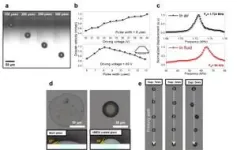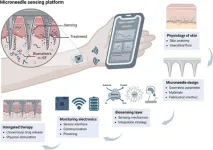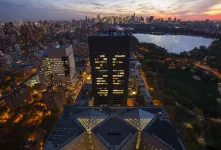(Press-News.org) Bioprinting is a technology used to create three-dimensional structures, such as human tissues or organs, using bio-inks made of cells and hydrogels. However, conventional inkjet technology has difficulty dispensing bio-inks that are sensitive to temperature due to the heat generated during operation. Furthermore, conventional 3D bioprinting mainly utilizes simple syringe-type printing devices with a single needle, making it time-consuming to produce artificial organs like the brain, lungs, and heart.
The Bionics Research Center team, led by Dr. Byung Chul Lee at the Korea Institute of Science and Technology (KIST, President Sang-Rok Oh), in collaboration with Dr. Seung-Hyup Baek’s team at the Electronic Materials Research Center and Professor Tae-Keun Kim’s team at Korea University (President Dong-Won Kim), has developed a bio-ink inkjet print head using the piezoelectric material PMN-PZT. This new print head is thinner but performs better than conventional designs. When applied, it enables the simultaneous dispensing of bio-ink at high resolution in multiple positions, significantly improving bioprinting productivity.
The research team developed a multi-nozzle inkjet print head using high-performance PMN-PZT thin films. This technology allows individual control of 16 ink ejection units arranged at 300 μm intervals, resulting in 16 times higher driving efficiency compared to than conventional methods. This enhancement boosts productivity and stability in bioprinting, reducing the production time for artificial organs.
In experiments, the team successfully printed hydrogels, a type of bio-ink, at a diameter of 32μm—half the size of conventional methods. The print speed achieved was 1.2 m/s, approximately 60 times faster than traditional methods. Additionally, the heat generation was reduced by 73.4%, keeping the temperature increase below 3.2 degrees Celsius during printing, ensuring a stable output environment. This allows for precise dispensing of high-viscosity materials and minimizes the deformation of temperature-sensitive bio-inks.
The PMN-PZT-based print head developed in this research can be utilized in organoid fields such as artificial organ transplants and drug toxicity evaluations, where thermal stability has been challenging. Furthermore, the operating temperature remains below 30 degrees Celsius, preventing the deformation of temperature-sensitive electronic materials and providing a stable printing environment. Therefore, it has the potential for broad application in various industries, including electronic components beyond the medical field.
Dr. Lee stated, “The new print head using PMN-PZT thin film material has enhanced the potential for high-resolution 3D organoid model production,” adding, “We plan to commercialize a 3D bioprinter capable of creating organs applicable for transplantation and toxicity evaluation by experimenting with various bio-inks such as gelatin.”
###
KIST was established in 1966 as the first government-funded research institute in Korea. KIST now strives to solve national and social challenges and secure growth engines through leading and innovative research. For more information, please visit KIST’s website at https://eng.kist.re.kr/
This research was supported by the Ministry of Science and ICT (Minister Sang Im Yoo) through KIST's Major Projects and the National Core Materials Research Project (NRF-2020M3D1A2101933) funded by the Ministry of Science and ICT (Minister Sang-Im Yoo). The research findings were published in the international journal Sensors and Actuators B: Chemical (IF 8.0, JCR field 0.7%).
END
High-performance inkjet print head enhances bioprinting productivity
Implementation of high-efficiency, low-heat bioprinting technology using piezoelectric thin film
2024-11-12
ELSE PRESS RELEASES FROM THIS DATE:
Opioid use disorder: Updated clinical practice guideline
2024-11-12
La version française suit
Opioid use disorder: updated clinical practice guideline
An updated evidence-based guideline aimed at helping clinicians and other health care providers manage patients with opioid use disorder recommends buprenorphine and methadone as first-line treatments. The guideline is published in CMAJ (Canadian Medical Association Journal). https://www.cmaj.ca/lookup/doi/10.1503/cmaj.241173
Opioid use and opioid use disorder are the leading causes of drug-related deaths worldwide, and Canada ...
Microneedle sensors for dermal interstitial fluid analysis
2024-11-12
The rapid advancement in personalized healthcare has driven the development of wearable biomedical devices for real-time biomarker monitoring and diagnosis. Traditional invasive blood-based diagnostics are painful and limited to sporadic health snapshots. To address these limitations, microneedle-based sensing platforms have emerged, utilizing interstitial fluid (ISF) as an alternative biofluid for continuous health monitoring in a minimally invasive and painless manner.
The team led by Wei Gao from California Institute of Technology providea a comprehensive overview of microneedle sensor technology, covering microneedle design, fabrication methods, ...
‘Sleepy cannabis’: first study to show cannabinol increases sleep
2024-11-12
Research by scientists at the University of Sydney has identified a constituent in the cannabis plant that improves sleep.
Their report is the first to use objective measures to show the component, known as cannabinol (CBN), increases sleep in rats.
The study has been published in the leading journal Neuropsychopharmacology.
“For decades, cannabis folklore has suggested that aged cannabis makes consumers sleepy via the build-up of CBN, however there was no convincing evidence for this,” said lead author on the study Professor Jonathon Arnold, ...
Mount Sinai team shows AI can detect serious neurologic changes in babies in the NICU using video data alone
2024-11-12
A team of clinicians, scientists, and engineers at Mount Sinai trained a deep learning pose-recognition algorithm on video feeds of infants in the neonatal intensive care unit (NICU) to accurately track their movements and identify key neurologic metrics.
Findings from this new artificial intelligence (AI)-based tool, published November 11 in Lancet’s eClinicalMedicine, could lead to a minimally invasive, scalable method for continuous neurologic monitoring in NICUs, providing critical real-time insights into infant health that have not been possible before.
Every year, more than 300,000 ...
Jeffrey Popma, MD, joins CRF as Chief Scientific and Strategic Officer
2024-11-11
NEW YORK – November 11, 2024 – The Cardiovascular Research Foundation® (CRF®) proudly announces the appointment of Dr. Jeffrey Popma as Chief Scientific and Strategic Officer. A world-renowned leader in cardiovascular research, Dr. Popma will drive forward pivotal programs and initiatives that will shape CRF’s future and fuel innovation at the CRF® Clinical Trials Center (CTC). His leadership will be instrumental in the development of the recently launched Real-World Data and Outcomes Center, advancing CRF’s commitment to impactful ...
Seiber elevated to IEEE senior member
2024-11-11
Larry Seiber, an R&D staff member in the Vehicle Power Electronics group at the Department of Energy’s Oak Ridge National Laboratory, has been elevated to senior member of the Institute of Electrical and Electronics Engineers, or IEEE.
Senior member status requires extensive experience that reflects professional accomplishments. Only 10% of IEEE’s more than 450,000 members achieve this level.
Seiber has conducted decades of cutting-edge research in power electronics and electric machinery. He developed the hardware ...
Study sheds light on how BRCA1 gene mutations fuel breast cancer
2024-11-11
People inherit two copies of each gene — one from each parent — an evolutionary fail-safe to ensure survival even when one of them doesn’t function.
For cancer-suppressor genes like BRCA1, researchers have long hypothesized that a single healthy copy could still guard against tumor development. Yet women with one harmful BRCA1 mutation are far more likely to develop breast cancer — a risk traditionally explained by a second mutation that arises later in life, damages the healthy copy of the gene, ...
A new wrinkle in turtles: Their genomes fold in a unique way, Iowa State researchers find
2024-11-11
AMES, Iowa – In their long strings of nucleotides, DNA molecules hold massive troves of genetic data providing instructions for how living organisms should function – the blueprint of life. How the blueprint is stored, however, impacts how it is read and used.
As cells divide and replicate, DNA strands coiled around proteins – chromatin – are in tightly bundled chromosomes. After division, the chromosomes loosen and chromatin is less compact. How and where the chromatin fiber folds and ...
Adequate sleep significantly reduces the risk of hypertension in adolescents, according to new study
2024-11-11
Adolescents who meet the recommended guidelines of nine to 11 hours of sleep per day were shown to have a significantly lower risk of hypertension, according to a new study from UTHealth Houston.
Recently published in the Journal of the American Heart Association, the research revealed that adolescents had a 37% lower risk of developing incidents of high blood pressure by meeting healthy sleep patterns, and underscoring the importance of adequate sleep behavior. The research further explored the ...
Research spotlight: Uncovering the mechanisms behind T cell differentiation
2024-11-11
How would you summarize your study for a lay audience?
T helper (TH) cells are essential immune cells that help other immune cells function effectively. When activated in response to environmental stimuli, these cells can differentiate into either TH1 cells, which fight against viruses and intracellular pathogens, or TH2 cells, which fight against extracellular pathogens like bacteria and parasites. However, scientists haven’t fully understood whether infected tissue itself has any role in directing the optimal T cell differentiation in response ...
LAST 30 PRESS RELEASES:
Exposure to natural light improves metabolic health
As we age, immune cells protect the spinal cord
New expert guidance urges caution before surgery for patients with treatment-resistant constipation
Solar hydrogen can now be produced efficiently without the scarce metal platinum
Sleeping in on weekends may help boost teens’ mental health
Study: Teens use cellphones for an hour a day at school
After more than two years of war, Palestinian children are hungry, denied education and “like the living dead”
The untold story of life with Prader-Willi syndrome - according to the siblings who live it
How the parasite that ‘gave up sex’ found more hosts – and why its victory won’t last
When is it time to jump? The boiling frog problem of AI use in physics education
Twitter data reveals partisan divide in understanding why pollen season's getting worse
AI is quick but risky for updating old software
Revolutionizing biosecurity: new multi-omics framework to transform invasive species management
From ancient herb to modern medicine: new review unveils the multi-targeted healing potential of Borago officinalis
Building a global scientific community: Biological Diversity Journal announces dual recruitment of Editorial Board and Youth Editorial Board members
Microbes that break down antibiotics help protect ecosystems under drug pollution
Smart biochar that remembers pollutants offers a new way to clean water and recycle biomass
Rice genes matter more than domestication in shaping plant microbiomes
Ticking time bomb: Some farmers report as many as 70 tick encounters over a 6-month period
Turning garden and crop waste into plastics
Scientists discover ‘platypus galaxies’ in the early universe
Seeing thyroid cancer in a new light: when AI meets label-free imaging in the operating room
Neutrophil-to-lymphocyte ratio may aid risk stratification in depressive disorder
2026 Seismological Society of America Annual Meeting
AI-powered ECG analysis offers promising path for early detection of chronic obstructive pulmonary disease, says Mount Sinai researchers
GIMM uncovers flaws in lab-grown heart cells and paves the way for improved treatments
Cracking the evolutionary code of sleep
Medications could help the aging brain cope with surgery, memory impairment
Back pain linked to worse sleep years later in men over 65, according to study
CDC urges ‘shared decision-making’ on some childhood vaccines; many unclear about what that means
[Press-News.org] High-performance inkjet print head enhances bioprinting productivityImplementation of high-efficiency, low-heat bioprinting technology using piezoelectric thin film






